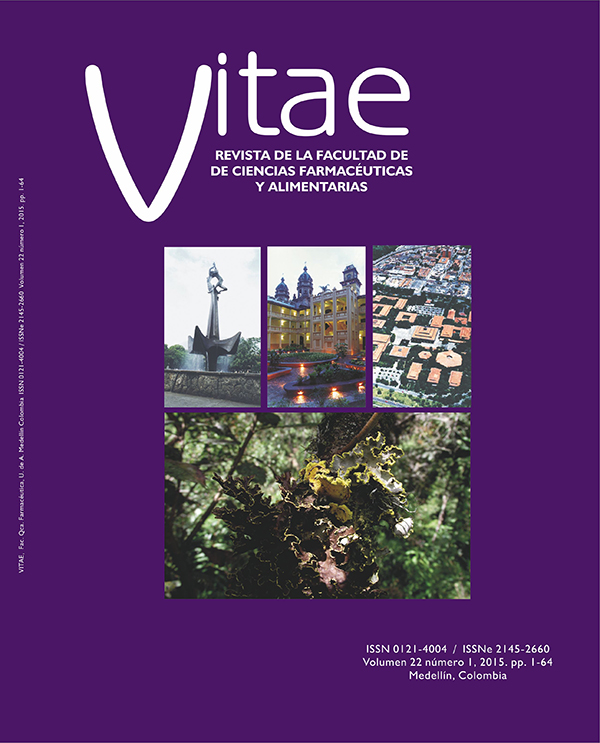Murine invariant natural killer T cells recognize glycolipids derived from extracts of the lichen Stereocaulon ramulosum
DOI:
https://doi.org/10.17533/udea.vitae.v22n1a02Keywords:
iNKT's, Glycolipids, CD1d, Lichens, AdjuvantAbstract
Background: Invariant natural killer T cells (iNKT ) can be activated by certain types of glycolipids that have the potential to generate adjuvant effects which could be used to develop effective and safe immunotherapies. Many of these glycolipids have been isolated from natural organisms, but there is a great amount of these organisms completely unexplored as a source of these types of compounds. Some of these organisms are lichens which are complex symbiotic organisms that have been showed to contain glycolipids. Objectives: We decide to test if glycolipids isolated from lichens would be able to actívate iNKT cells in vitro and in vivo. Methods: We have used extracted glycolipids from 43 different species of lichens from Colombia. We have used iNKT hybridoma cells, C57BL/6 mice, IL-2 ELISA and the B16 melanoma to test for the adjuvant capabilities of glycolipids isolated from lichens. Results: In this study we have found two glycolipids with the capacity to activate iNKT cells in vitro. One of the glycolipids was able to activate iNKT cells in vivo, and was competent to induce protection against the B16 melanoma in the mouse model. Conclusions: We propose a possible chemical structure for a novel glycolipid called β-GalCer-lich (1) derived from the lichen Stereocaulon ramulosum.
Downloads
References
Baena A, Porcelli SA. Evasion and subversion of antigen presentation by Mycobacterium tuberculosis. Tissue antigens. 2009 Sep;74(3):189-204.
Arora P, Baena A, Yu KO, Saini NK, Kharkwal SS, Goldberg MF, et al. A single subset of dendritic cells controls the cytokine bias of natural killer T cell responses to diverse glycolipid antigens. Immunity. 2014 Jan 16;40(1):105-16.
Carreno LJ, Kharkwal SS, Porcelli SA. Optimizing NKT cell ligands as vaccine adjuvants. Immunotherapy. 2014 Mar;6(3):309-20.
Brennan PJ, Brigl M, Brenner MB. Invariant natural killer T cells: an innate activation scheme linked to diverse effector functions. Nature reviews Immunology. 2013 Feb;13(2):101-17.
Rappuoli R, Aderem A. A 2020 vision for vaccines against HIV, tuberculosis and malaria. Nature. 2011 May 26;473(7348):463-9.
Koff WC, Burton DR, Johnson PR, Walker BD, King CR, Nabel GJ, et al. Accelerating next-generation vaccine development for global disease prevention. Science. 2013 May 31;340(6136):1232910.
Kinjo Y, Tupin E, Wu D, Fujio M, Garcia-Navarro R, Benhnia MR, et al. Natural killer T cells recognize diacylglycerol
antigens from pathogenic bacteria. Nature immunology. 2006 Sep;7(9):978-86.
Kinjo Y, Illarionov P, Vela JL, Pei B, Girardi E, Li X, et al. Invariant natural killer T cells recognize glycolipids from
pathogenic Gram-positive bacteria. Nature immunology. 2011 Oct;12(10):966-74.
Downloads
Published
How to Cite
Issue
Section
License
Copyright Notice and Open Access Statement
The Journal Vitae works under the Open Access license, and the published manuscripts remain available for the public, both on the Journal's website and in databases, under the Creative Commons license, "Noncommercial Attribution" and "Share alike" systems, adopted in Colombia. Hence, when the authors agree to publish in the Journal Vitae, they will not have the right to economic retributions on publications and reproductions through different diffusion media. The documents are freely available to the internet public, permitting users to read, download, copy, distribute, print, search, or link to the full texts and pass them as data to software. The only constraint on reproduction and distribution, should be to give authors control over the integrity of their work and the right to be appropriately acknowledged and cited.
Authors declare that:
-
They are the intellectual property owners and are responsible for all the information stated in the article.
-
This manuscript has not been submitted or published in other printed or digital media. They accept the responsibility for the judgments, opinions, and points of view expressed in the published article and, therefore, they exonerate Universidad de Antioquia and Journal Vitae from any process.
-
They exempt Universidad de Antioquia and Journal Vitae from settling conflicts or disputes related to the authorship of the referred article.
-
They accept the revision of the original manuscript by suitable personnel, and they bind themselves to perform the corrections appointed or suggested by the assessors.
-
Therefore, they know the editorial process and will not bind the Editorial Board of the Journal to assume any obligations regarding the volume and issue in which the article is published.
-
They transfer the rights of publication, reprinting, and distribution of the article from the moment of its approval, in print and digital format, without the right to economic rewards, and under the licensing conditions considered relevant by Journal Vitae.
-
They fully authorize Universidad de Antioquia and Journal Vitae to submit the published material to the diverse databases and indexing systems where the Journal can be found to comply with the requirements of the regulatory authorities to maintain the national classification of journals.
-
They will assume the article publication costs established for the current issue, and they will make the payment as soon as they are informed about the volume and the issue in which the final version of the article is published.
-
After the article is published, you can share digital or printed copies in a noncommercial manner. You will be able to use the paper in your institution or company for educational or research purposes, including the use in course programs.
Conflict of interest: Authors are responsible for recognizing and disclosing any financial or other benefits that could be perceived to bias their work, acknowledging all financial support and any personal connections with potential sponsors. Examples of such conflicts include receiving research funds or honoraria, serving on advisory boards, stock ownership, or employment and consulting arrangements. Authors without such connections should clearly state that they have no financial support or personal relationships that could be perceived to bias their work. All conflicts of interest should be disclosed on the author's identification page of the manuscript.










